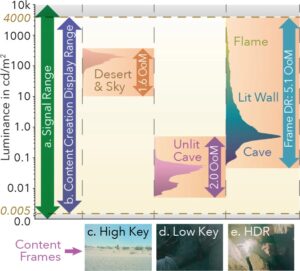I’m a great believer in the saying ‘If you can’t measure it, you can’t manage it’, but measuring displays is really, really tricky. However, that doesn’t mean you shouldn’t try.
More than thirty years ago, selling high end CRT-based monitors, I found that an image that was ‘good enough’ was really hard to define. CRT-based displays were never perfect (and anything close to the published spec would have been considered ‘not good enough’). We had a customer that was really dissatisfied with his product. He sent it back, but our tests showed that it was well within the specification (and that model was probably the best looking commercial monitor on the market at that time, being based on the most expensive Sony Trinitron CRT available. Sony used a cheaper version in its desktop monitors). I explained to him that ‘Our products are the best there is, but they are not perfect’. Still, we wanted him to be happy, and I often found that the trickiest buyers were the ones that helped you get better as a supplier. So, I looked for a solution.
I suggested that when we next had a shipment of monitors coming in, he could sit behind the engineer (and he was an engineer from the factory in Japan) when we performed our ‘goods inwards’ inspection, and, if he saw a monitor that he preferred, he could swap it for the one we first sent.
He came to the workshop on that basis and watched the inspection process on a dozen or so samples of that model. He then decided, having seen how many different factors of focus, uniformity, geometry, linearity and colour purity were involved in getting a really good CRT monitor, that he would keep the first one we supplied to him!
Anyway, although we have now got digital products that are much, much more uniform and higher quality than those products, the demands that we make of the displays have risen along with their ability to deliver. HDR is a particular challenge.
IDMS to the Rescue
The first version of the IDMS standard which sets out ways to measure displays was published before HDR display was a consumer technology. I heard Dolby talking about the technology at a conference that I organised, the DisplayForum in 2007 in Prague, but it took a long time to get to market.
Anyway, as I have previously reported, the IDMS has a new version, Issue 1.1 (ICDM Has IDMS V1.1 and Other Acronyms) and included along with the procedures for testing, it has a 40 page tutorial section that explains HDR in great detail, looking from the top down at the overall concept, down to the issues of signals, metadata, tone mapping, display devices and applications. If every reviewer of an HDR TV, BD player or service read those 40 pages, the world would be a better place! The IDMS is free to download here.
However, to give an introduction to the topic, occasional Display Daily contributor and image quality maven, Florian Friedrich and Timo Kunkel, a a senior staff color and imaging researcher in the CTO office of Dolby Labs, wrote an introduction to the topic and the tutorial in the SID’s Information Display magazine and the article is free to view. The article looks at topics including the bit depth needed for different HDR systems to avoid visible contouring artefacts. It also highlights the wide range of brightness of content that can be captured and displayed in HDR.
Of course, the display is dependent on the signal that is sent to the unit and so the article looks at the ways that content can be created or captured, delivered and displayed – the stages it describes as the ‘fundamental pipeline segments’. It highlights that many of the potential ‘gotchas’ of measuring HDR are eliminated by standardising the test signal, so the IDMS1.1 does that.
The article covers the particular importance of ensuring the right viewing environment when looking at HDR. I was struck by the similarity of the diagrams in the article and the photos that Pete Putman included in his article about the actual contrast seen in viewing environments rather than the paper specifications. (Can a Display Be Too Bright?)
At Display Daily, we’re keen to promote better practice in display measurement and better understanding of display issues, so this article is being published outside the paywall. Reading it won’t count as one of your free articles if you don’t have a full subscription. (BR)


